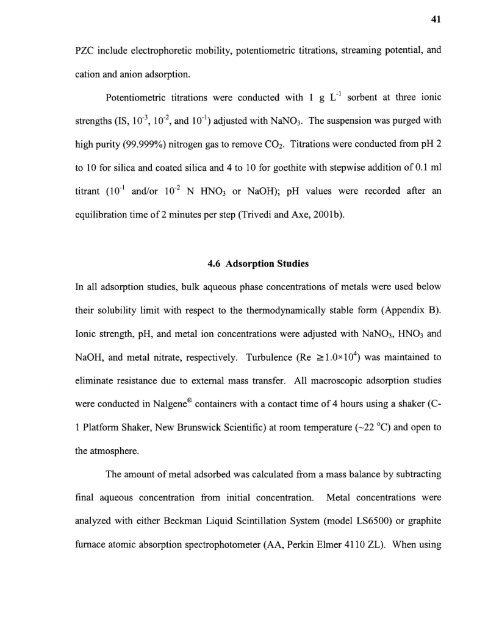Heavy metal adsorption on iron oxide and iron oxide-coated silica ...
Heavy metal adsorption on iron oxide and iron oxide-coated silica ...
Heavy metal adsorption on iron oxide and iron oxide-coated silica ...
You also want an ePaper? Increase the reach of your titles
YUMPU automatically turns print PDFs into web optimized ePapers that Google loves.
41PZC include electrophoretic mobility, potentiometric titrati<strong>on</strong>s, streaming potential, <strong>and</strong>cati<strong>on</strong> <strong>and</strong> ani<strong>on</strong> <str<strong>on</strong>g>adsorpti<strong>on</strong></str<strong>on</strong>g>.Potentiometric titrati<strong>on</strong>s were c<strong>on</strong>ducted with 1 g L-1 sorbent at three i<strong>on</strong>icstrengths (IS, 10 -3, 10-2, <strong>and</strong> 10-1 ) adjusted with NaNO3. The suspensi<strong>on</strong> was purged withhigh purity (99.999%) nitrogen gas to remove CO2. Titrati<strong>on</strong>s were c<strong>on</strong>ducted from pH 2to 10 for <strong>silica</strong> <strong>and</strong> <strong>coated</strong> <strong>silica</strong> <strong>and</strong> 4 to 10 for goethite with stepwise additi<strong>on</strong> of 0.1 mltitrant (10 -1 <strong>and</strong>/or 10-2 N HNO3 or NaOH); pH values were recorded after anequilibrati<strong>on</strong> time of 2 minutes per step (Trivedi <strong>and</strong> Axe, 2001b).4.6 Adsorpti<strong>on</strong> StudiesIn all <str<strong>on</strong>g>adsorpti<strong>on</strong></str<strong>on</strong>g> studies, bulk aqueous phase c<strong>on</strong>centrati<strong>on</strong>s of <str<strong>on</strong>g>metal</str<strong>on</strong>g>s were used belowtheir solubility limit with respect to the thermodynamically stable form (Appendix B).I<strong>on</strong>ic strength, pH, <strong>and</strong> <str<strong>on</strong>g>metal</str<strong>on</strong>g> i<strong>on</strong> c<strong>on</strong>centrati<strong>on</strong>s were adjusted with NaNO3, HNO3 <strong>and</strong>NaOH, <strong>and</strong> <str<strong>on</strong>g>metal</str<strong>on</strong>g> nitrate, respectively. Turbulence (Re 1.0x10 4) was maintained toeliminate resistance due to external mass transfer. All macroscopic <str<strong>on</strong>g>adsorpti<strong>on</strong></str<strong>on</strong>g> studieswere c<strong>on</strong>ducted in Nalgene® c<strong>on</strong>tainers with a c<strong>on</strong>tact time of 4 hours using a shaker (C-1 Platform Shaker, New Brunswick Scientific) at room temperature (-22 °C) <strong>and</strong> open tothe atmosphere.The amount of <str<strong>on</strong>g>metal</str<strong>on</strong>g> adsorbed was calculated from a mass balance by subtractingfinal aqueous c<strong>on</strong>centrati<strong>on</strong> from initial c<strong>on</strong>centrati<strong>on</strong>. Metal c<strong>on</strong>centrati<strong>on</strong>s wereanalyzed with either Beckman Liquid Scintillati<strong>on</strong> System (model LS6500) or graphitefurnace atomic absorpti<strong>on</strong> spectrophotometer (AA, Perkin Elmer 4110 ZL). When using
















